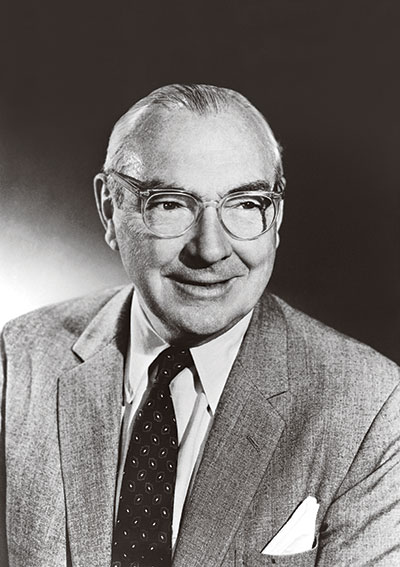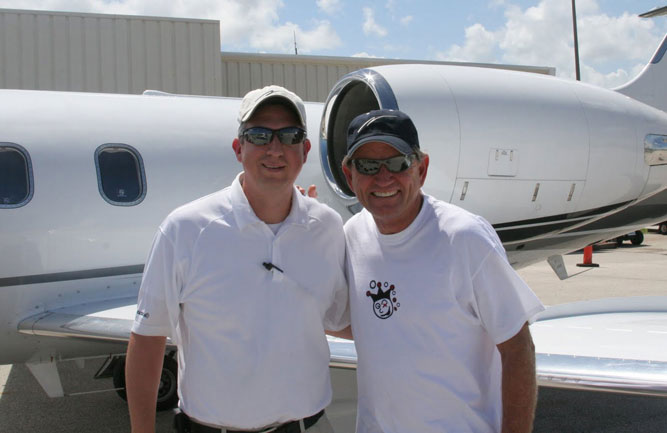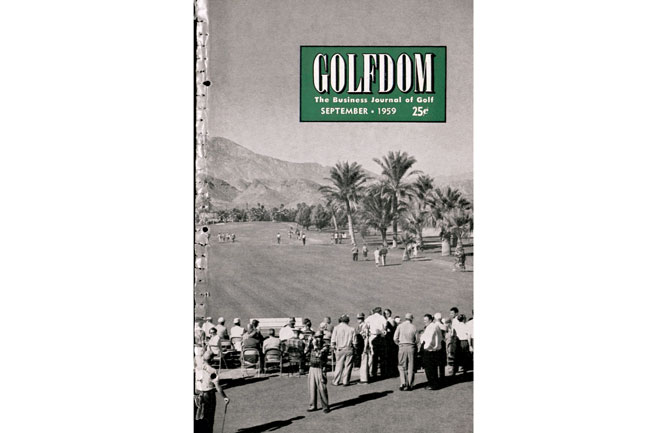Memories of Mr. Golf
 Rees Jones likes to recall the good humor of Herb Graffis by looking back at one of the hilarious letters Graffis wrote to his father, Robert Trent Jones Sr.
Rees Jones likes to recall the good humor of Herb Graffis by looking back at one of the hilarious letters Graffis wrote to his father, Robert Trent Jones Sr.
“This was Herb Graffis,” chuckles Jones, “The Open Doctor,” when speaking of Golfdom’s founder, the same man who founded the National Golf Foundation, the Club Managers Association of America and the Golf Writers Association of America. “He always had a twinkle in his eye. He loved life, he loved his friends, he loved to be funny and he loved to write.”
Keeping up with Jones
Graffis was born in 1893, a native of Logansport, Ind. He and his brother Joe founded Chicago Golfer in 1927, Golfdom in 1927 and Golfing in 1933. According to the World Golf Hall of Fame, the Graffis brothers almost went broke in 1936 while creating the National Golf Foundation. But that didn’t stop Herb from experiencing a lifetime in golf, including being honored in 1977 as the first journalist inducted into the World Golf Hall of Fame, which noted, “His greatest contributions to the game came not from what he wrote, but through the conception of his ideas.”
Robert Trent Jones Sr. and Herb Graffis were lifelong friends, and Rees Jones to this day believes his father would not have been as successful were it not for the help of Graffis and Golfdom.
“Golfdom and my father go back to the 1930s, Rees Jones says. “Golfdom was the magazine that tells you the nuts and bolts of the industry. Herb Graffis always knew where all the projects were, he always knew what was going on, and he would relay that to my dad. And Golfdom is still that today… I’m very proud to be associated with the magazine.”
James R. Hansen, Ph.D., author of the book, “A Difficult Par,” about the life of RTJ Sr., agrees with Rees Jones’ assessment.
“(Jones’) communication with the Graffis brothers really opened the window on golf and what was going on in other parts of the country, especially in the Midwest,” Hansen told Golfdom. “Jones was a regular advertiser and a regular letter writer (to) the Graffis brothers, and in turn, they sort of scratched each other’s backs. Jones’ first course in the Midwest was a connection the Graffises gave him. The relationship with Jones and the Graffis brothers was very important to Jones, especially early in his career.”
The last time Rees Jones saw Graffis was at the American Society of Golf Course Architects meeting in 1977, the same year Graffis was inducted into the World Golf Hall of Fame. Jones says that despite ailing health, Graffis never changed, even in his later years.
“He never lost his spirit, no matter that he was losing his eyesight or his mobility,” Jones says. “He never won a single tournament, but he won a lot of hearts. He left a phenomenal legacy for the game of golf.”
A golf prophet
Gary Wiren, Ph.D., is a member of the PGA Hall of Fame and World Golf Teachers Hall of Fame. Regularly recognized in Golf magazine as one of America’s top 100 teachers, Wiren is senior director of instruction for all Trump golf properties, teaching out of Trump International Golf Club in West Palm Beach, Fla. He has authored 14 golf books, including 1990’s “The PGA Teaching Manual: The Art and Science of Golf Instruction.”
Wiren still has some of the letters Graffis wrote to him, and says that even though Graffis has been gone for almost 30 years, he still considers himself a friend and fan of the man.
“He loved to have fun, he understood that golf needed to be more fun, more enjoyable, and that’s why he wanted to have driving ranges with beer gardens,” Wiren laughs. “It has come true now in the last 10 years, where we have the triple-decker ranges where people can drink and eat and hit balls at the range.”
Wiren calls Graffis a “prophet” for such ideas as the driving range with the beer garden, but also for founding the National Golf Foundation with his brother Joe, for starting various publications like Golfdom, Golfing and Chicago Golfer, and the idea of promoting the game to the masses.
“Herb wasn’t interested in grip, stance and swing. He was interested in having the game be more attractive to all types of people,” Wiren says. “(Herb and Joe) were not just pandering to the moneyed and private golf world. They were very much into public golf and promoting golf to municipalities and places where public golfers could play. The idea that golf was for all people, it wasn’t just for the elite — that was pretty strong with Herb.”
Insightful, funny and salty
Jerry Tarde, chairman and editor-in-chief of Golf Digest, has been with the magazine since 1977. He first met Graffis during his days as a student at Northwestern University in Chicago in the early 1970s.
There are three American journalists in the World Golf Hall of Fame, and Tarde had the honor of inducting two of them: Herbert Warren Wind (2008) and Dan Jenkins (2012). He was just getting his start at Golf Digest when Graffis was inducted in 1977. But last year at the National Golf Foundation’s Golf Business meeting, Tarde was asked to speak about Graffis on the NGF’s 80th anniversary. Tarde was happy to recall the man whom he first met at a Chicago trade magazine cocktail hour.
“That night in Chicago when I was a kid without a job, Herb Graffis took me under his wing and became my great encourager,” Tarde told the group. “He was born in 1893, so I met him when he was about 83. He lived to 95. It was one of my first lessons: Always find the oldest guy in the room and go talk to him.”
Tarde said that Graffis was the best storyteller he ever heard, even if he was sometimes… blue.
“He was insightful, funny and salty. His vocabulary was an education in backstreet biology,” Tarde laughed. “He was the consummate after-dinner speaker in golf, in a different time… women and children had to be cleared from the room before he spoke.”
Tarde went on to tell several stories of Graffis, read excerpts of his writings and honor his mentor with a final toast. “I only knew (Graffis) when he was legally blind, for the last dozen years of his life,” Tarde concluded. “He could make out only basic shapes. He followed golf in the end by watching it on television. He saw more as a blind man than most of us see with our sight.”
Excerpt from a letter from Herb Graffis to Robert Trent Jones Sr., written Aug. 17, 1970.
Dear Trent:
Soon there may be a new award in golf, The Scum Trophy, to be awarded annually to the tournament professional with the worst manners. And at the presentation, the ill-bred winner will show his appreciation by returning all the prize checks he got during the year.
The old poet (who) wrote you couldn’t make a velvet purse of a sow’s ear might be amazed to see how you can make a golf tournament star of a pig’s ass; in fact the uncouth bum will do the job without any help.
I cannot say much for the job by golf writers during this development of destructive stupidity. The smart old golf writers who weren’t handcuffed by dependency on pro stars saved golf from ignorant pros’ offenses.
Those writers did the pros a lot of good. I remember how Sarazen used to criticize National Open courses just to get his name in the papers… and our Gene was hungry for that. But Westbrook Pegler wrote a column saying, in effect, if that caddie doesn’t like the course on which he is being allowed to play for a chance at far more money than he’s worth in honest labor, why doesn’t he stay out of the tournament, join the club, pay dues and have the course built the way he wants it? Or shut up. Who sent a cab for him?…
And that was a fortunate change of life for our Gene. He began to get good manners and show some of the polish to which he was exposed. I admire Gene one hell of a lot. He had the brains enough to see the difference between class and sewage and go for class…












